An Immodest Introduction
Just about every major decision or commitment that I’ve made has been contrarian. Sometimes this tendency merits pride, and sometimes it warrants shame. Admittedly, being contrarian does sound cool, but I’m learning to proceed with humility, lest I conclude that it’s “better to reign in Hell than serve in Heaven.”
Much to the chagrin of my reasonable parents, my wife and I wed when I was 19 years old. I’m not entirely sure that I am a man now, but I certainly was not then. I left a semi-prestigious college after my freshman year to transfer schools in order to live my married undergrad life in a region I found more to my tastes—indeed, a sophomoric decision. While studying English at my small liberal arts Bible college in Northeast Georgia, I started reading Christian thinkers from the new-monastic movement and pretended to be a socialist. My wife and I dropped out of college when I was 3 credit hours shy of graduation, because we were presented with the option of backpacking around Europe in lieu of me taking a French class. (I did ultimately graduate.) We moved back to Toledo, OH after our European trip to live in the hood, where I took a job at a startup non-profit. When The People’s Payout of 2008 took its toll, I was let go from my job. So, we gallivanted around North America in a van. (I postured as though it was some kind of altruistic endeavor, but it was more or less a year of debauchery.) With $50 in our bank account, we moved back to Toledo. I took another job, started a business or two, ran a farm in the city, vehemently argued with City Hall, and became an aspiring Agnosto-Buddhist. During that chapter, there was great melody, merry-making, and gnashing of teeth. Shortly after that season, I again found great joy walking with Christ.
Then our feet got itchy again, and we left, moving to beautiful Western North Carolina in 2019. I started working at a Transcendental Meditation Retreat Center, but when various governments decided that everyone would be safer from the bad cold if all non-essential jobs (i.e., small businesses that were not selling alcohol) were shuttered, I lost my job. So, I determined that I would find a job that was more immune to the whims of the oligarchs. Sometime around the beginning of June 2020, I applied to be a police officer. It was the summer of burning love, or something. Then, when it was the least fashionable career choice imaginable, at age 34, I went to Basic Law Enforcement Training (Rookie School).
Yes. If there’s one thing I can find, it is the prevailing winds of culture. I’ve been tacking for a long time, and fighting against those winds has offered me a pretty curious life. There are much faster, smarter, and more advisable ways to get to where you’re going; however, I’m cursed with this disposition, and it has more or less remained unchanged.
To backtrack a bit: in September of 2016, I had the privilege of speaking at a TEDx event in Toledo, OH. I shared a 13-minute presentation on the relationships between soil, food, and humans. While researching my presentation, I came across a study published in 2015 by researchers from the University of Warwick, the University of Manchester, and somewhere in Denmark. The research examined how depression and other emotional states spread within student populations. The UK studies, published in the journal Royal Society Open Science, aimed to understand if mood and mental health symptoms like depression could be "contagious" in social networks, specifically among adolescent and university-age students. Unsurprisingly, they found that depression was socially transmissible. The researchers discovered that depression and depressive symptoms could be influenced by social connections.
At that time, I wrote a second part of my TEDx Talk, which delved into the ramifications of how we were feeding and raising children at that time. I started scribbling down some ideas about the massive increase in melancholy and sexual deviance as symptoms of social contagion. Back then, I was less confrontational, so I ultimately cut the talk short and kept it amiable. I was working with hundreds of students every year (medical, undergrad, and primary alike) and did not want to harm any of those relationships. But in truth, I was looking at something that was an obvious cultural shift among young folks. I could see it then: the prevailing winds were changing. My Rust Belt community of outsiders, artists, mad farmers, and activists was becoming the dominant cultural voice. The valedictorians were getting nose rings, the athletically inclined were openly teased, and the kids from the youth group had already voted for Obama twice—the first time out of defiance and the second time out of guilt. The non-binary identifier was on a bull run, as it seemed a convenient way to join a marginalized class at no great cost. In 2016, it was a faux pas among the aging hipster class to even feign conservatism, and that millennial class has managed to age into the dominant culture. Now, in 2024, it is more apparent than ever. The “progressives” are guiding our society one cringey Verizon Commercial at a time, and now I am compelled to push back against it.
Where is the Counterculture?
If I’d hitched a ride in a flying DeLorean and told Scott in 2008 this news, he would have asked why he became such a curmudgeon and probably assumed that mustaches would be uncouth. In truth, it would have been inconceivable. It made sense to criticize the neo-cons fresh on the heels of Bush-era soccer moms espousing evangelical conservatism, but now the soccer moms and the Cheneys are all lobbying for progressives. Censorship has pivoted from the Religious Right wanting to ban The Catcher in the Rye to the new woke left wanting to ban To Kill a Mockingbird. Free speech is a prerequisite for identifying counterculture, and we live in a time where it is increasingly censored by the party that used to defend it.
For the purposes of this rambling, I’d like to define counterculture as a movement or set of beliefs that actively resists or critiques the dominant social, political, and cultural norms. The counterculture seeks to challenge established ideas, often aligning with values that run counter to the prevailing attitudes of the time. Counterculture is marked by a spirit of dissent and an inclination to question authority, offering alternative views that go beyond surface-level disagreement, aiming instead to unsettle and redefine the status quo.
Honestly, conservatism has seemingly emerged as the new voice of criticism, embracing the open and free exchange of ideas. In an era where the liberal establishment seems firmly entrenched—dictating much of what is deemed acceptable in media, academia, and the arts—those identifying as conservative now occupy a peculiar position. Once the presumed defenders of the “status quo,” today’s conservatives find themselves challenging what many see as an increasingly rigid and self-satisfied liberal orthodoxy. Disillusionment with established norms, frustration with the performance of our institutions, and the sense that modern progressivism controls nearly every mainstream channel have driven conservative thought to don the role of cultural rebellion.
The new conservative is a questioner, pushing back against an entrenched cultural narrative and reclaiming the autonomy of discourse. The following is a list of questions and comments that certainly merit (or merited) open debate. They will (or did) also get you pilloried in the digital public square.
“Are there really 54 genders?”
“Why is almost every school shooter taking SSRIs?”
“I think the coronavirus came from the Wuhan Institute of Virology, famous for being an active research center for studying coronaviruses.”
“Do I really need my 13th booster?”
“Why is my church closed while the bar is open?”
“Do you sell raw milk?”
A New Subversive Identity
Countercultural movements require an established order to critique. In the 1960s, the counterculture targeted systemic injustices—racial, social, and economic—putting the left in a subversive role. In the early 2000s, the counterculture pushed back against state moralism and the military-industrial complex. Conversely, Shelby Steele reflects on the irony of today’s role reversal: “Conservatism became the new counterculture—a movement subversive to the established liberal cultural order.” Steele points out that post-1960s liberalism took on a “hunger for innocence,” setting itself up as the morally pure ideology, while the specter of America’s historical failings was cast on conservatism alone. By claiming to absolve the nation from the sins of its own past, liberalism constructed a moral high ground that allowed it to present conservatism as a repository of guilt—a “seemingly endless font of power” for the left, as Steele describes it.
“This ability to taint conservatism…with America’s past shames has been, for the Left, a seemingly endless font of power.”
~ Conservatism as Counterculture by Shelby Steele
In recent years, liberalism’s determination to escape America’s past has fostered its appearance of virtue while relegating conservatism to an association with bigoted bygone eras. But this distancing act has ironically created a vacuum—a chance for conservative thought to step back into the role of a questioner, challenging the once-transformative moral authority that liberalism used to hold over culture. Today, conservatism stands, as Steele puts it, “the new counterculture,” poised to take on the mantle of dissent.
“Dissociation is a cultural template that tries to make America, and the greater Western world, entirely accountable for its past oppressions and all the damage done by them.”
~ Conservatism as Counterculture by Shelby Steele
I think it’s apparent that liberalism/leftism/progressivism (whatever you want to call it) is the dominant cultural voice. They determine the scope of the Overton Window, the parameters of misinformation, and the relevant cultural talking points. One thing I’ve noticed is that I’m not just bothered by the content of what the dominant culture espouses, but the tone with which they communicate it. The condescending and relentless didactic nature of their lectures is the most unbecoming demeanor I can possibly imagine.
The Hipster Sneer and Cultural Authority
Dudley Newright describes how younger liberals, especially millennials, engage in “hipster sneering” as a means of signaling status, turning politics into an aesthetic rather than a serious engagement with ideas. It’s not enough for millennials to just vote the “right” way; they have to laugh at the “right” jokes, see the “right” films, and wield the “right” symbols. This form of cultural signaling has turned liberalism into a uniform of sorts, where signaling one’s beliefs becomes a performance rather than genuine engagement. On Millennial Snot by Mr. Newright is absolutely my favorite thing I’ve read in a long time. He writes, “These are middle-aged PhDs with prestigious careers, talking like snotty teenagers or sassy black drag queens... It’s the defining feature of our degraded public discourse.” If the established pillars of modern society are appropriating the nonsensical intonation of the underclass, it’s obvious that the establishment perceives itself as a coalition-member of the underprivileged.
A further generational shift has made this even more apparent, particularly in the mockery that Gen Z heaps on what it calls “millennial core”—a cringeworthy, performative style of liberalism that feels hollow. Newright explains, “Zoomers have picked up on millennial speech patterns and started to openly mock them as ‘millennial core.’” For Gen Z, weary of the virtue-signaling and aesthetic conformity, conservatism has taken on a fresh appeal, offering a space where ideas aren’t reduced to status symbols. In a strange twist, conservatism has come to represent an escape from performative ideology.
I think that castigating others for holding opinions that fall outside of the leftist dogma is evidence of the fragility of the subscriber to the dominant cultural idea. Newright echoes this idea, writing, “Downwardly mobile young people have long turned to hipster sneering as a way to signal status…many turned to politics, which for them became their aesthetic.” There is safety in joining a herd and adopting its tone and mentality, especially when that herd appears nice and safe. “Millennials cultivated a fierce loyalty to ‘being a decent human being.’ They don’t just vote for the right candidate; they laugh at the right jokes, watch the right movies, and deploy and retract the right symbols and signifiers at the right time.”
Dissident Conservatism and the Rejection of Cultural Stagnation
It’s easy to mock the aimless dogma of the leftist dominant culture, but coming up with a superior option is not easy. Solutions require work. Criticism doesn’t. In his article The Dissident Right and its Discontents, Dave Greene notes that “Contemporary people are not interested in engaging with ideas, but in shutting them out, so that the same familiar tropes can play out over and over again.” So, how do we live out an aspirational vision to offer something True and Beautiful?
Greene notes that this “secular orthodoxy” of mainstream liberalism is a system held up by “dead abstractions” rather than ideas that meet people’s real need for purpose and clarity. The orthodoxy Greene critiques is steeped in Enlightenment ideals (universal equality, secularism, and rationalism), which he argues have calcified over time, leaving a void for those searching for meaning. According to Greene, this stagnant liberalism has left conservatism with a dissident purpose: to “clear away the dead things… and open the doors to a new era where human thriving can be pursued earnestly.” Here, the dissident right finds itself as the sole place where discourse remains vital, challenging a liberal order that feels increasingly cut off from the desires for authenticity and deeper purpose. Greene writes, “The dead abstractions that have ruled us in the 20th century are fading away, and now new and vital things can take their place… to clear away the dead things, to put their memory to rest, and to open the doors to a new era where human thriving can be pursued earnestly.”
The liberal establishment’s emphasis on America’s historical injustices and its didactic tone have alienated many, dismissing traditional values as relics of oppression. Steele argues that this “dissociation” from America’s past has allowed liberalism to reshape traditionalism as inherently tainted. But in a culture where the present is marked by this relentless disowning of the past, conservatism’s willingness to engage with, rather than dismiss, America’s heritage gives it an unexpected subversive appeal. For Steele, conservatism’s goal is not a backward-looking nostalgia but a purposeful “clearing away”—a countercultural stance against a liberalism that holds a monopoly on moral purity but often struggles to provide real engagement with history, meaning, and just maybe… God.
Where Do We Go From Here?
In 2024, conservatism has taken on the traits of rebellion. This shift goes beyond mere policy disputes; it’s a fundamental cultural reversal in which conservatism now embodies the countercultural spirit of dissent. Conservative voices are increasingly calling for a return to authenticity, tradition, and honest dialogue, serving as a foil to the performative, cynical moralism of today’s progressive, sarcasm-laden discourse.
This new conservative rebellion challenges the belief that conservatism must stand for the status quo. As Greene contends, I hope we can build a culture “where discourse still feels alive and meaningful. Although none of us have power, and our organization efforts have just started in earnest, these alternative spaces are one of the few places where people are talking about the things that MATTER.” Let us listen first, and then respond. I pray the days of silencing “uncouth” ideas have run their course. I don’t want to burn down cities or storm capitals. I want to play the Marriage of Figaro over the prison yard like Andy Dufresne. The world is full of drab, concrete structures; degrading, repetitive music; compulsory applause at comedy clubs; and endless androgynous superhero movies. Let us bring it something revolutionary!
“Finally, brothers and sisters, whatever is true, whatever is noble, whatever is right, whatever is pure, whatever is lovely, whatever is admirable—if anything is excellent or praiseworthy—think about such things.”
Here are a few more thoughts for our historical moment: I’m convinced that Donald Trump will be viewed as a countercultural icon in decades to come. I hope that he and his band of antagonists of the status quo are successful in their endeavor to reform the food system, disrupt the pharmaceutical industry, defund the military-industrial complex, fight DC corruption, and cut the fat from our federal government. It'll be a genuine miracle if they are remotely successful in any of those pursuits.
I’ve included a few graphs illustrating how the dominant culture is stacked against Trump.
In spite of increased representation in all forms of media and strong support for individuals coming out, Gen Z contends that they are experiencing discrimination based on their gender identity at higher rates than older generations. This seems a bit paradoxical.
Lastly, here’s a list of celebrity presidential endorsements.
Kamala Harris Endorsements: Taylor Swift, Beyoncé, Barack and Michelle Obama, John Legend and Chrissy Teigen, George Clooney, Pol Pot, Mark Hamill, Megan Thee Stallion, Quavo, Rosie O'Donnell, Jamie Lee Curtis, Shonda Rhimes, Spike Lee, Abigail Disney, Rob Reiner, Charli XCX, Barbra Streisand, Moloch, Eminem, Billie Eilish, Cher, Ariana Grande, Jennifer Lopez, Lady Gaga, Kerry Washington, Jane Fonda, Katy Perry, Janelle Monáe, Samuel L. Jackson, Alyssa Milano, Mindy Kaling, Lizzo, America Ferrera, and Debra Messing.
Donald Trump Endorsements: Elon Musk, Kid Rock, Hulk Hogan, and Dana White.





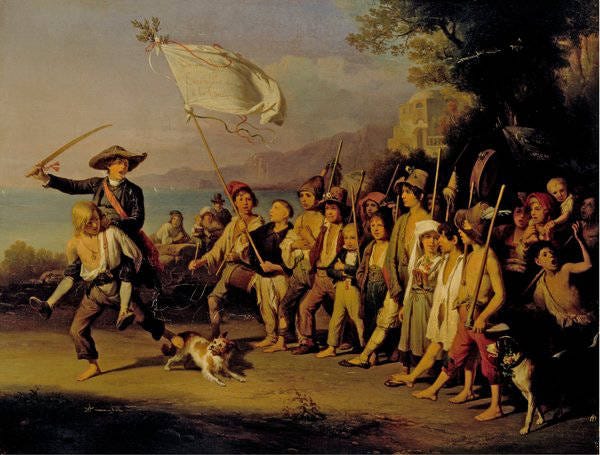
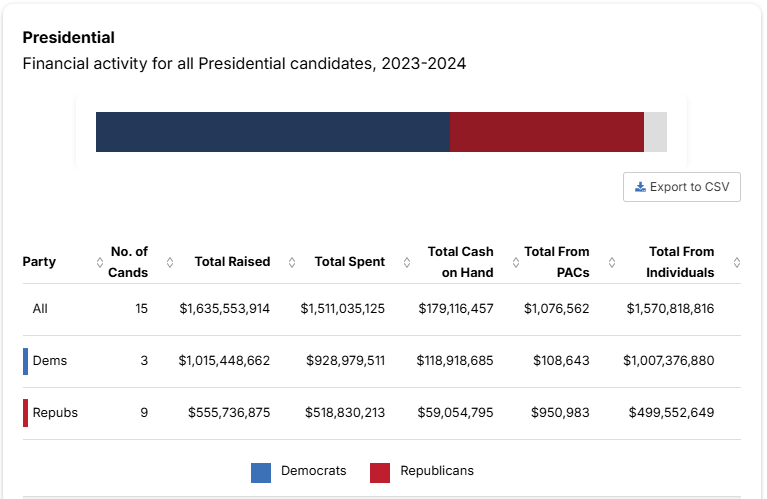
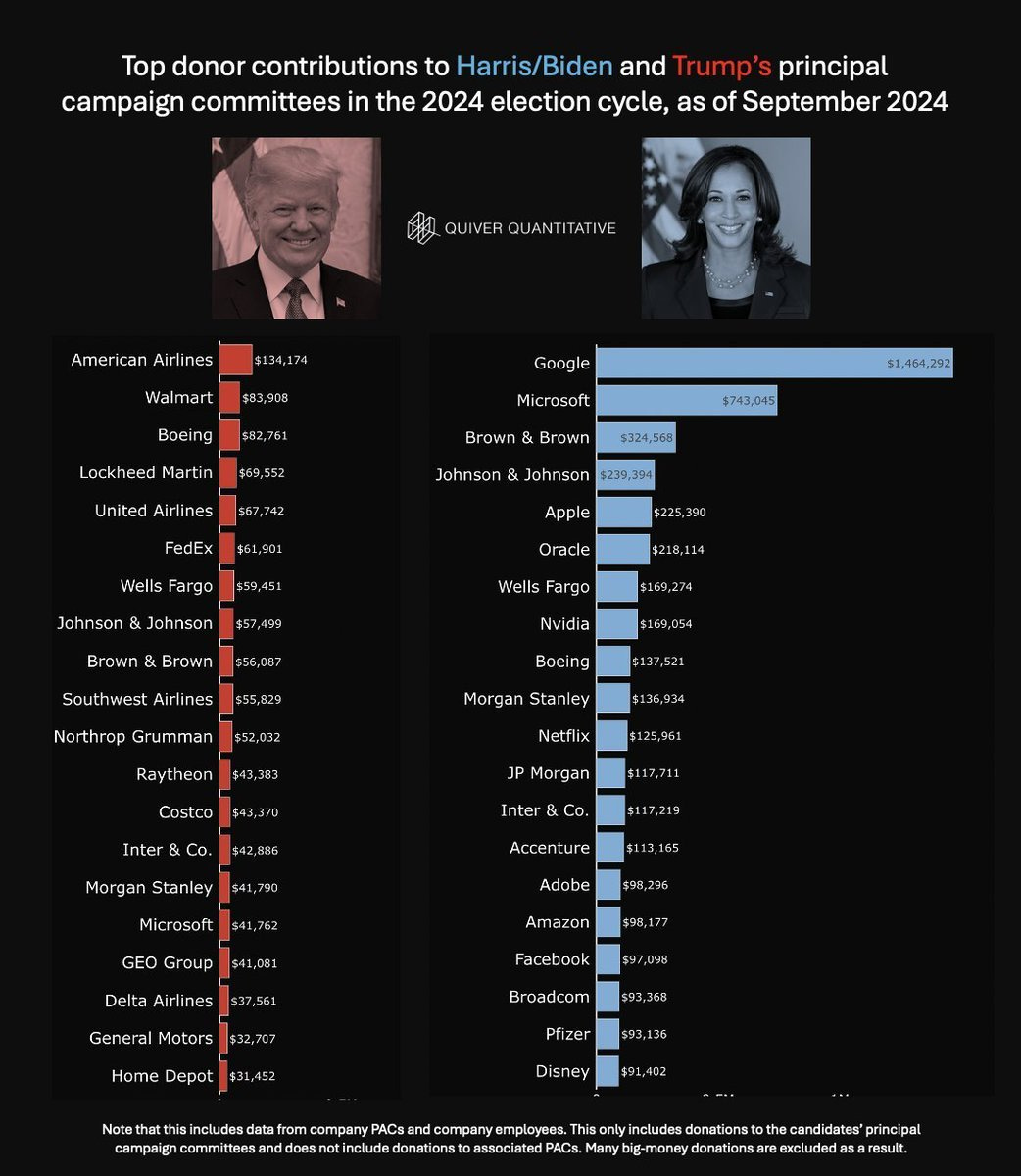
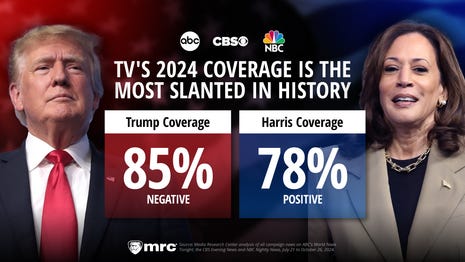
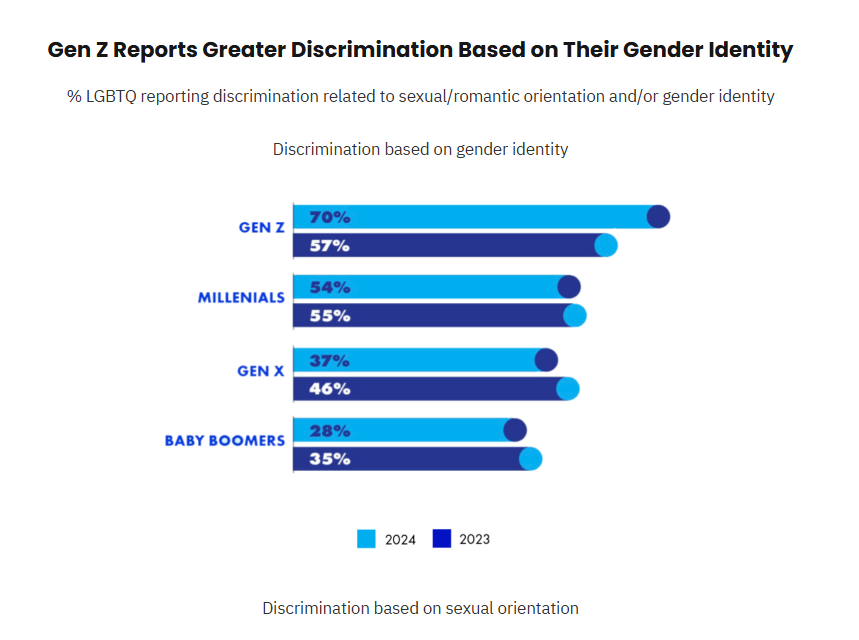
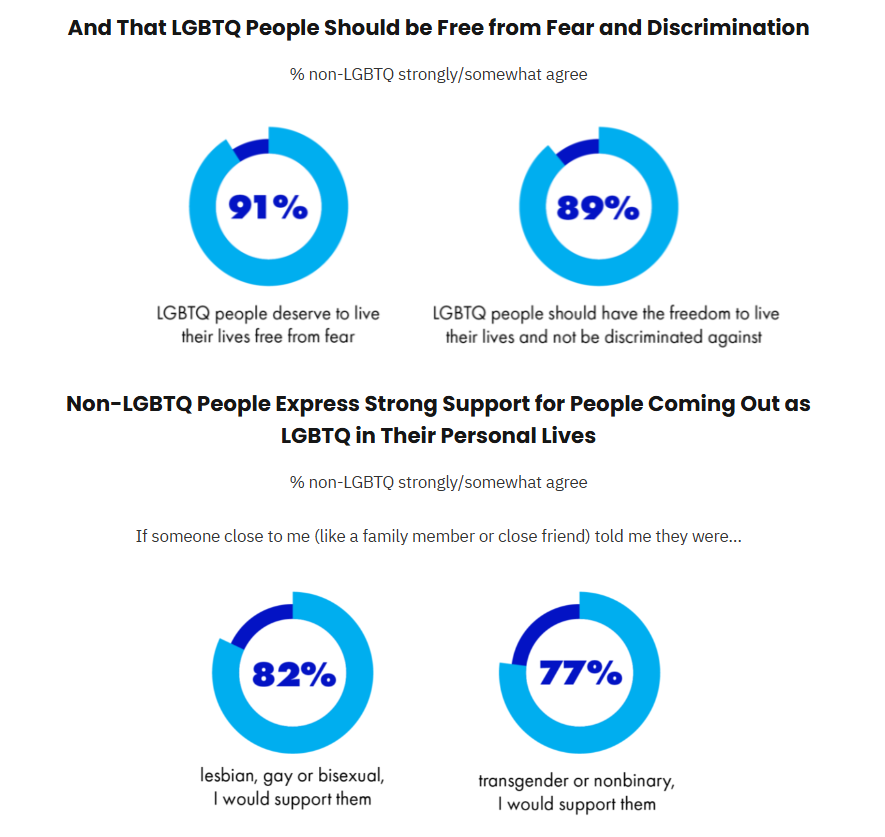
Don't forget Bobby!